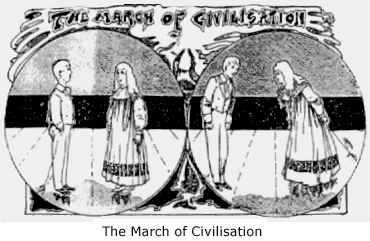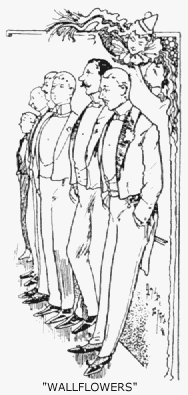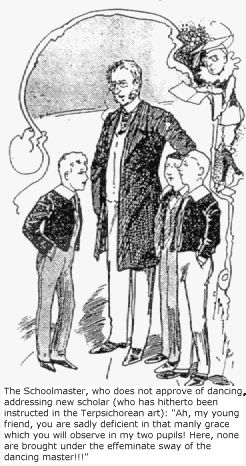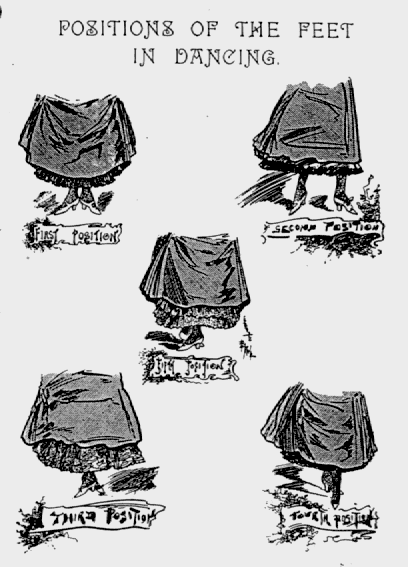JUVENILE INSTRUCTION
[p.7] IT would appear that not until the closing years of the Nineteenth Century have
parents come to realise the fact  that
dancing and physical culture form an indispensable part of their children's education.
Those holding opposite opinions are in a hopeless minority; even those who may not be
altogether enamoured of the dancing art see the folly of letting foolish prejudice stand
in the way of their children acquiring that physical culture which the highest medical
authorities emphatically maintain is as much a part of a child's education as any other
subject. Many a mother has cause to regret that she neglected to realise the truth of
this; for instance, she may have a family of grown-up [p.8] children, none of whom have
ever had a single lesson in either dancing, deportment, or physical culture. We will take
it that they are all out of their teens, and "done growing." that
dancing and physical culture form an indispensable part of their children's education.
Those holding opposite opinions are in a hopeless minority; even those who may not be
altogether enamoured of the dancing art see the folly of letting foolish prejudice stand
in the way of their children acquiring that physical culture which the highest medical
authorities emphatically maintain is as much a part of a child's education as any other
subject. Many a mother has cause to regret that she neglected to realise the truth of
this; for instance, she may have a family of grown-up [p.8] children, none of whom have
ever had a single lesson in either dancing, deportment, or physical culture. We will take
it that they are all out of their teens, and "done growing."  In her girls she finds round shoulders, turned in feet, an
ungraceful carriage, and shy and awkward manners in society, which they share with their
brothers - poor wallflowers, all of them, handicapped in the race of life through no fault
of their own. It behoves all parents, then, to lose no time in sending their children to
qualified teachers as soon as possible. It is no use sending a child for a year and then
breaking off the course of tuition. Moreover, a regular attendance is absolutely
necessary. Children's minds cannot possibly be expected to be retentive, if one month they
are occupied at the dancing class, and the next find themselves amid different
surroundings, and the lessons things of the past. In her girls she finds round shoulders, turned in feet, an
ungraceful carriage, and shy and awkward manners in society, which they share with their
brothers - poor wallflowers, all of them, handicapped in the race of life through no fault
of their own. It behoves all parents, then, to lose no time in sending their children to
qualified teachers as soon as possible. It is no use sending a child for a year and then
breaking off the course of tuition. Moreover, a regular attendance is absolutely
necessary. Children's minds cannot possibly be expected to be retentive, if one month they
are occupied at the dancing class, and the next find themselves amid different
surroundings, and the lessons things of the past.  It is
said, with a certain amount of truth, that this is an age of over education. The
increasing prevalence of ophthalmia among children is eloquent testimony of a distressing
aspect [p.9] of the question. Therefore, the dancing and physical exercises become a
necessity, It is a relief to the brain fag which must be doubly more acute in a child than
in an adult, after a long period of mental application. It is no exaggeration to say that
five is by no means too young for a child to commence. This will astonish many. We can
bear their exclamation of surprise, "Nonsense, no child so young could possibly
learn." But here they make a great mistake; children at that age, although, as a
rule, not observant, soon develop that faculty, and the fascination of the dancing lesson
gives them the desire to learn. The present day teacher, therefore, in order to make his
class a success, has to make it attractive. The old-fashioned method of keeping pupils at
steps for season after season is quite out of date, and unsuited for the rising
generation; they look upon the class as a bore, and the parents would declare their
children were learning nothing. It is
said, with a certain amount of truth, that this is an age of over education. The
increasing prevalence of ophthalmia among children is eloquent testimony of a distressing
aspect [p.9] of the question. Therefore, the dancing and physical exercises become a
necessity, It is a relief to the brain fag which must be doubly more acute in a child than
in an adult, after a long period of mental application. It is no exaggeration to say that
five is by no means too young for a child to commence. This will astonish many. We can
bear their exclamation of surprise, "Nonsense, no child so young could possibly
learn." But here they make a great mistake; children at that age, although, as a
rule, not observant, soon develop that faculty, and the fascination of the dancing lesson
gives them the desire to learn. The present day teacher, therefore, in order to make his
class a success, has to make it attractive. The old-fashioned method of keeping pupils at
steps for season after season is quite out of date, and unsuited for the rising
generation; they look upon the class as a bore, and the parents would declare their
children were learning nothing.  Moreover,
if children dread their dancing lesson, what possible good can it do them; they will
certainly not do their teacher any credit in the end. The lesson should be made so
enjoyable that the pupils would look forward to it with delight. At the same time, the
teacher must use discretion, and assert his authority when necessary to keep the children
in order. We note with regret that the old prejudice against -dancing still holds its
blighting sway in some boys' schools. Some masters hold ideas not one whit in advance of
the Puritans, who pulled down the Maypoles in England; they look upon dancing or
deportment as unworthy, if not dangerous, to engage the attentions of their pupils. Those
unlucky [p.10] youngsters whose superior appearance of refinement proclaims the fact that
their parents have sent them to a dancing class, generally come in for sneering remarks on
their effeminacy, invariably made in the presence of the other less fortunate boys. This
is written from personal experience, and is a grievance which calls for immediate remedy.
It all rests in the hands of the parents. As it is, there are signs of improvement in this
direction; the position of such bigots in trying to stem the march of civilisation is akin
to that of Mrs. Partington with her Mop, trying to stem the inroad of the Atlantic Ocean.
Many old prejudices are dying with the century, some hard, but that against dancing is
having a speedy dissolution. In a well [p.11] ventilated room, and under a qualified
teacher, dancing is one of the most graceful of exercises, and one of the most fruitful
sources of health. The actual effort to dance gracefully awakens a corresponding desire to
be gracious in manner, impressing upon the young mind the true value and beauty of
politeness and graciousness of manner not to be forgotten in after life. Moreover,
if children dread their dancing lesson, what possible good can it do them; they will
certainly not do their teacher any credit in the end. The lesson should be made so
enjoyable that the pupils would look forward to it with delight. At the same time, the
teacher must use discretion, and assert his authority when necessary to keep the children
in order. We note with regret that the old prejudice against -dancing still holds its
blighting sway in some boys' schools. Some masters hold ideas not one whit in advance of
the Puritans, who pulled down the Maypoles in England; they look upon dancing or
deportment as unworthy, if not dangerous, to engage the attentions of their pupils. Those
unlucky [p.10] youngsters whose superior appearance of refinement proclaims the fact that
their parents have sent them to a dancing class, generally come in for sneering remarks on
their effeminacy, invariably made in the presence of the other less fortunate boys. This
is written from personal experience, and is a grievance which calls for immediate remedy.
It all rests in the hands of the parents. As it is, there are signs of improvement in this
direction; the position of such bigots in trying to stem the march of civilisation is akin
to that of Mrs. Partington with her Mop, trying to stem the inroad of the Atlantic Ocean.
Many old prejudices are dying with the century, some hard, but that against dancing is
having a speedy dissolution. In a well [p.11] ventilated room, and under a qualified
teacher, dancing is one of the most graceful of exercises, and one of the most fruitful
sources of health. The actual effort to dance gracefully awakens a corresponding desire to
be gracious in manner, impressing upon the young mind the true value and beauty of
politeness and graciousness of manner not to be forgotten in after life.

|
![]()
![]()
![]()
![]()